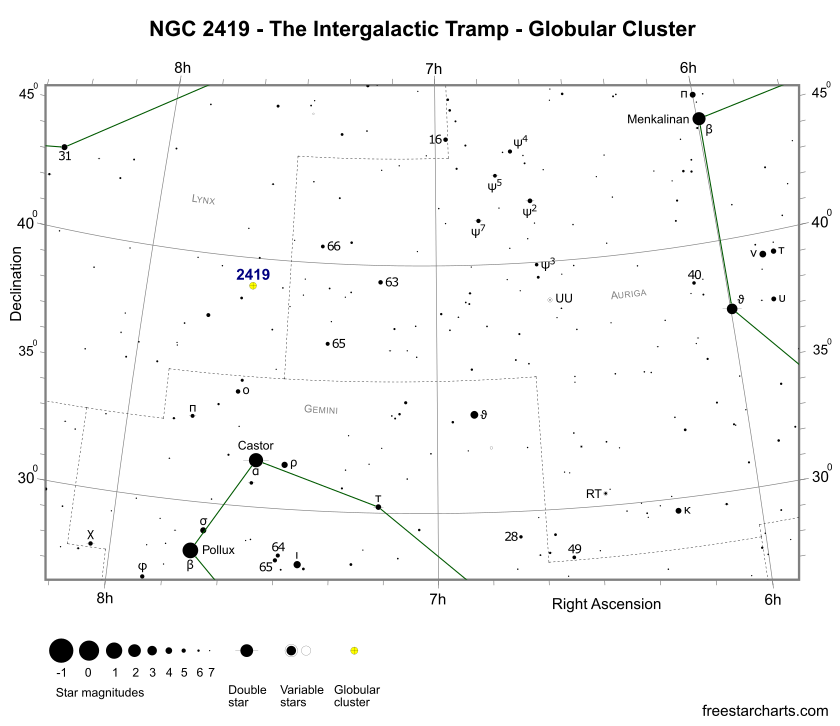Lynx is home to the fascinating globular cluster, NGC 2419. Although visually small and faint what makes it special is its distance, at 275,000 light-years it's one of the furthest known Milky Way globulars. In fact, twentieth century American astronomer Harlow Shapley nicknamed it "The Intergalactic Tramp", believing it to have broken possibly away from the Milky Way and headed off into deep intergalactic space. However, recent observations indicate Shapley hypothesis was incorrect and NGC 2419 is still gravitationally bound to the Milky Way, just moving in a highly eccentric orbit.
NGC 2419 or Caldwell 25 was discovered by William Herschel on December 31, 1788. It's located 275,000 light-years from the Solar System and about 300,000 light-years from the galactic centre, which is almost twice as far as the Large Magellanic Cloud. At such a distance, it's estimated NGC 2419 will take about 3 billion years to complete a single orbit around the centre of the galaxy.
NGC 2419 is positioned 7 degrees north and slightly east of the second brightest star in Gemini, Castor (α Gem - mag. +1.58). About 4 arc minutes west of NGC 2419 is a mag. +7.2 star with a double star of mag. +7.9 a few more arc minutes further west. Even Herschel with his super telescopes of the time, couldn't resolve NGC 2419 into stars. William Parsons, the 3rd Earl of Rosse, using his 72-inch (1.83 m) reflecting telescope at Birr Castle in Ireland - the largest optical telescope in the world at the time - was first the first to do so in 1850.


Finder Chart for NGC 2419 - pdf format (credit:- freestarcharts)
NGC 2419 shines at magnitude +10.3 and has an apparent diameter of 5 arc minutes. It's a somewhat challenging target, especially under light polluted skies. In good conditions, it can be spotted with a small 100mm (4-inch) instrument. A 150 mm (6-inch) scope, at low magnifications, reveals a small fuzzy object that's clearly non-stellar in nature. Larger scopes fair better, but don't expect to resolve NGC 2419, its brightest stars are of magnitude +17.
The globular is best seen from northern latitudes during the months of December, January and February. Although faint and unimpressive, this incredible object is one of the largest and intrinsically brightest globulars known. It's estimated to contain a million stars spread across a spatial diameter of 400 light-years and is comparable in brightness to spectacular Omega Centauri.
NGC 2419 Data Table
| NGC | 2419 |
|---|---|
| Caldwell | 25 |
| Name | The Intergalactic Wanderer |
| Object Type | Globular Cluster |
| Constellation | Lynx |
| Distance (light-years) | 275,000 |
| Apparent Mag. | +10.3 |
| RA (J2000) | 07h 38m 08s |
| DEC (J2000) | 38h 52m 53s |
| Apparent Size (arc mins) | 5 x 5 |
| Radius (light-years) | 200 |
| Age (years) | 12.6 Billion |
| Number of Stars | 1 Million |